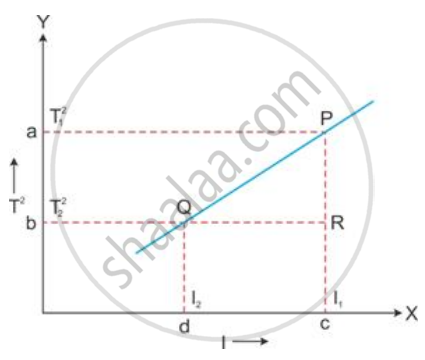Advertisements
Advertisements
Question
How does the time period (T) of a simple pendulum depend on its length (l)? Draw a graph showing the variation of T2 with l. How will you use this graph to determine the value of g (acceleration due to gravity)?
Solution
The time period of a simple pendulum is directly proportional to the square root of its effective length.
`T ∝ sqrt(l)`

From this graph, the value of acceleration due to gravity (g) can be calculated as follows.
The slope of the straight line can be found by taking two points P and Q on the straight line and drawing normals from these points on the X- and Y-axis, respectively. Then, the value of T2 is to be noted at a and b, the value of l at c and d. Then,
Slope = `"PR"/"QR" = "ab"/"cd" = (T_1^2 - T_2^2)/(l_1 - l_2)`
This slope is found to be constant at a place and is equal to `(4pi^2)/"g"` , where g is the acceleration due to gravity at that place. Thus, g can be determined at a place from these measurements using the following relation:
`"g" = (4pi^2)/("Slope" "of" T^2 "Vs" l "graph")`
APPEARS IN
RELATED QUESTIONS
A microscope is provided with a main scale graduated with 20 divisions in 1 cm and a vernier scale with 50 division on it of length same as of 49 divisions of main scale. Find the least count of the microscope.
The main scale of a vernier callipers is calibrated in mm and 19 divisions of main scale are equal in length to 20 divisions of the vernier scale. In measuring the diameter of a cylinder by this instrument, the main scale reads 35 divisions and 4th division of vernier scale coincides with a main scale division. Find
(i) Least count and (ii) Radius of a cylinder.
Define the term frequency.
Two simple pendulums A and B have equal lengths, but their bobs weigh 50 gf and 100 gf, respectively. What would be the ratio of their time periods? Give reasons for your answer.
What do you understand by the term degree of accuracy?
Explain the method in steps to find the volume of an irregular solid with the help of a measuring cylinder.
Amongst the unit of volume which is most suitable for measuring:
Volume of a glass filled with milk
Is there any difference in the following measurements?
(a) 51.7 cm
(b) 51.70 cm
(c) 51.700 cm.
Explain your answer.
Which measurement is most accurate?
